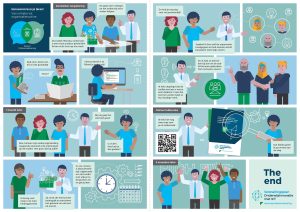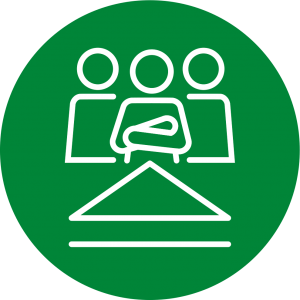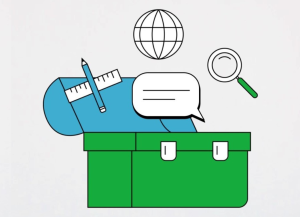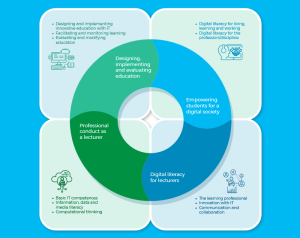
Implementing educational innovations in higher education: from initiation to organizational routine
Educational innovation using ICT has been a priority in higher education for years, due to its impact on the quality


The integral IT motion sensor is an instrument for analysing the status of educational innovation with IT within the university or college of higher education. The University of Twenteand Avans University of Applied Sciences tried it out. “The motion sensor allows you to take a razor-sharp picture, and that is very valuable.”
What is the status of educational innovation with IT within our higher education institution? Such a broad question is not easy to answer. Instructor A may well be busy in front of the green screen in the DIY studio, but instructor B still seems to be having difficultyintegrating himself into Teams. What is the reason for that? And what does it say about the institution as a whole?
The Facilitating professional development for lecturers zonemapped out the most important factors that play a role in educational innovation with IT. The zone came up with four pillars: Vision and policy; Leadership; Professionalisation and IT infrastructure. The pillars and associated indicators were combined in the integral IT movement sensor, which according to the manual is ‘an instrument for getting thinking and acting on educational innovation with IT moving within the institution’.
The motion sensor consists of a inspirational cartoon, discussion cards, reflection cards, and a manual. Prior to a session with the motion sensor, participants answer a number of questions. The Leadership pillar, for example, includes the indicator ‘initiators’: the extent to which formal or informal leaders stimulate educational innovation with IT. Questions on this indicator include: Who act as initiators within the institution? What is the evidence for this? To what extent are they encouraged in this by their managers? By comparing the answers of various stakeholdersand discussing them in breakout sessions, an overview emerges of where the institution stands on each pillar.
“The motion sensor is a useful tool for getting the discussion going,” says Edwin Zeelenberg, ICTO coach at the Academy for Part-time Students at Avans University of Applied Sciences. It makes visible where you stand in relation to your goal. In our session, a lot of information was brought from unconscious to conscious.
“Take the pillar Vision and Policy,” adds his colleague, ICTO coach Yvette van den Bersselaar. “I think that the vision of our part-time academy on educational innovation is not quite right on paper yet, but I didn’t know whether colleagues think that way too. By talking about it explicitly with each other, you notice that it has a broader impact. Where do we want to be in five years time?
It is precisely the differences that make the use of the motion sensor useful. At the University of Twente (UT), where the motion sensor was also tested, they discovered a difference in insight regarding the pillar Vision and Policy – where one participant thought that the policy on educational innovation was well organised, another wondered whether there was any policy at all. “Among other things, we learned that although we offer a lot of support in educational innovation with ICT, lecturers do not always have an overview of what is available,” says Hans Oeloff, director of HR at the UT. “The range of services must be better publicised”.
André de Boer, professor of mechanical engineering, agrees. He attended the UT’s online session because he was asked by his former employer to take stock of the need for new audiovisual resources. “It turns out we already have a lot, but many teachers don’t know it’s there,” he says. “Sometimes they see something beautiful in the lecture hall that they want to use, but there is no manual available, for example. Above all, we need to invest in a good support team that is readily available and can help on the spot.”
At Avans, lecturers experience the professionalisation offerings as fragmented, says HRD advisor Marlies Otten. “The motion sensor confirms what we already know, including that the basic IT skills of not all lecturers are up to standard. I haven’t heard anything new and that’s reassuring. I normally speak to the people who were present at the session as well, but we rarely speak to each other all together. That’s the added value of such a session.”
As a result of the motion sensor, she made a list of action points with colleagues. It says, for example, that support should be brought closer to the workplace, that Avans should focus more on valuing educational innovation and that a good overview of the IT infrastructure is needed: what is used where, where are there duplications, is it easy to find for lecturers?
“We are here now, but it is only beginning,” says Otten. She is pleased that the subject is considered important enough within the organisation to devote an afternoon to it. “It will be interesting to see if the use of the motion sensor keeps going.”
Even though a lot is already happening on all pillars of the motion sensor, when asked what is still missing, the various stakeholders mainly look at each other. Zeelenberg says: “For many parts of the motion sensor, it is important that the management indicates the direction in the first instance, supports the initiative, or ensures that it can be tackled integrally.”
Sarah Wilton, member of the Avans Board of Governors, thinks that teachers and ICTO coaches should be allowed to take up the space. “As administrators, we are not the experts in the field of educational innovation with IT; we like to be inspired by them. Just start! There is a budget, there is extra capacity, really not everything has to succeed. Perhaps we should be clearer about that and encourage it even more.”
In order to get even more out of the motion sensor, Jan-Laurens Lasonder, director of IT-services at the UT, would like to see the instrument used more broadly, for instance within a faculty, together with lecturers and students. He is particularly interested in comparing the results. It is about the differences in perception. What we at UT can do even more rigorously is to take action on the points where we do not score well’.
A session with the motion sensor is valuable but intensive, is the tenor. Discussing the conclusions of the group in front of you and then elaborating on them takes a lot of time. One afternoon is not enough, all interviewees agree. “With the motion sensor you make a razor-sharp picture and that is very valuable,” says Wilton. “The tool forces people to speak out. If your goal is to create movement, you will need to repeat the motion sensor periodically, to evaluate and take new steps.”
The latter is crucial. The motion sensor brings the action points into focus, but then it is a matter of turning the picture into a video, as it were, and getting the organisation moving.
Read more about the Motion Sensor here or get started right away.
Text: Marjolein van Trigt
Image: Bill Oxford via Unsplash
Share this page

Educational innovation using ICT has been a priority in higher education for years, due to its impact on the quality

Blended learning. A concept that is high on the agenda in education land. Are you working on blended learning within

Making optimal use of the possibilities of IT in higher education requires new knowledge and skills from lecturers. As a

Do you want to know which digital competences of lecturers are relevant for educational innovation with IT? Then get to